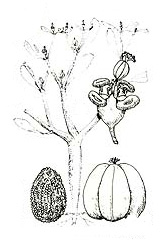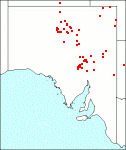Family: Euphorbiaceae
Euphorbia stevenii
Citation:
Bailey, Qld Agric. J. 25:288 (1910).
Synonymy: E. murrayaria J. Black, Trans. R. Soc. S. Aust. 56:42 (1932).
, Euphorbia murrayana Common name: Bottletree spurge (or caustic).
Description:
Glabrous perennial (? biennial) herbaceous herb, 10-50 cm tall, stem erect, smooth, thick and slightly swollen cylindrically in the lower part, 5-9 mm diam., rigid but rather succulent, branching dichotomously; the branches repeatedly forked, soon becoming leafless; cauline leaves alternate, becoming subopposite on upper branches, on distinct petioles to 3 mm long, oblong-oblanceolate, 10-30 x 3-5 mm, obtuse, shortly attenuate towards the base, distinctly lacerate distally, with spreading teeth, covered with scattered trichomes; stipules 2, subulate, minute, caducous.
Cyathia solitary and axillary or mostly terminal, on short peduncles to 0.5 mm long at anthesis, to 1 mm long in fruit; involucre campanulate, c. 1.5 mm long and wide, yellow-green; glands reniform, c. 0.8 mm long, red, without appendages; male flowers 4 or 5; styles ascending, short, thick, notched into 2 clavate tips.
Capsule on an erect pedicel 3-6 mm long, almost spherical, 3-lobed, c. 5 x 6-6.5 mm, smooth, dull-green; seed ovoid, 2.5-3.5 x 2-3 mm, with a ventral brown raphe, appearing smooth but actually minutely and densely papillose with minute white tubercle-like papillae, initially white but becoming grey or brownish, carunculate.

| Euphorbia stevenii habit, fruit and seed.
|
Image source: fig 402h in Jessop J.P. & Toelken H.R. (Ed.) 1986. Flora of South Australia (4th edn).
|
Published illustration:
Cunningham et al. (1982) Plants of western New South Wales, p. 458; Jessop (1981) Flora of central Australia, fig. 210B.
|
|
Distribution:
|
Occasional in sandy soils or clay loams.
S.Aust.: LE, GT, FR, EA. N.T.; Qld; N.S.W.
|
Conservation status:
native
Flowering time: probably all year around.
|

SA Distribution Map based
on current data relating to
specimens held in the
State Herbarium of South Australia
|
Biology:
Stems and branches glaucous and rich with milky sap, shrivelling on drying. There is no positive evidence that it is poisonous. (Everist (1974) Poisonous plants of Australia, p. 275).Fig. 402H.
Taxonomic notes:
Resembles E. parvicaruncula which has quadrangular tuberculate seeds with a hooded caruncle; differs from E. tannensis subsp. eremophila which also has quadrangular-papillose seeds but a large hat-shaped caruncle and more slender stems.
Author:
Not yet available
|

